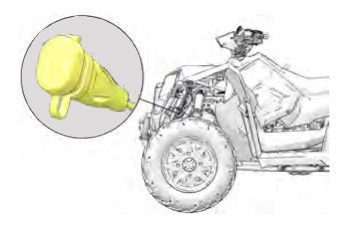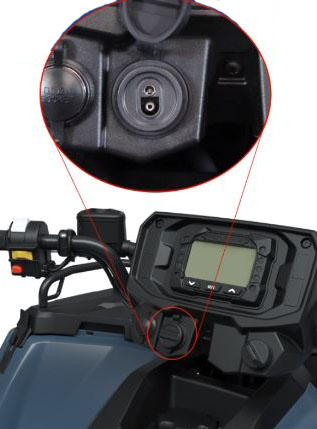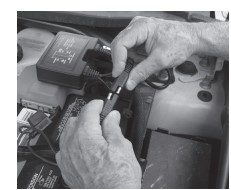The following video covers battery charging and maintenance tips for Polaris Off-Road Vehicles. Watch for general battery maintenance tips (0:48), conventional battery charging information (1:50), Absorbed Glass Mat battery charging information (3:38), low maintenance battery charging information (5:37) and how to charge deeply discharged batteries (6:57).
All Polaris Off-Road Vehicles include either a conventional battery or a sealed, low maintenance battery. When performing maintenance on any battery, note that improperly connecting or disconnecting battery cables can result in an explosion and cause serious injury or death. When removing your battery, always disconnect the negative (black) cable first. When reinstalling the battery, always connect the negative (black) cable last.
Using a new battery that has not been fully charged can damage the battery and result in a shorter life. It also can hinder vehicle performance.
Make sure your battery connections are tight. This reduces voltage drop and ensures a reliable connection between the vehicle and the battery.
Always keep your battery terminals and connections free of corrosion. Batteries will self-discharge more quickly when dirty. If cleaning is necessary, remove the corrosion with a terminal brush. Wash with a solution of one tablespoon baking soda and one cup water. Rinse well with tap water and dry off with clean shop towels. Coat the terminals with dielectric grease or petroleum jelly. Be careful not to allow cleaning solution or tap water into a conventional battery.
Conventional Batteries
Conventional batteries have removable cap plugs located on the top of the battery and a vent tube located on the side of the battery.
Lead Acid Conventional batteries must be fully charged before use or their life will be significantly reduced by 10 to 30 percent of the battery's full potential.
The battery's nominal voltage is 12.6 to 12.8 Volts when fully charged. If the voltage falls below 12.5V, charge it immediately or the battery runs the risk of sulfation. Polaris recommends using a BatteryMINDer® 12V 1.5 AMP Convertible charger. Charge the battery with a charging output no larger than 1/10 of the battery's amp/hr rating.
Recharge the battery to its full capacity every 30 to 60 days.
The BatteryMINDer® 12V Convertible charger is part number 2830511. For more information, view the installation instructions.
If the battery is stored or used in a partially charged condition or with low electrolyte levels, hard crystal sulfation will form on the plates, reducing the efficiency and service life of the battery.
A poorly maintained battery will deteriorate rapidly. Check the battery fluid level often. Maintain the fluid level between the upper (1) and lower level (2) marks. Add only distilled water. Tap water contains minerals that are harmful to a battery.
Battery electrolyte is poisonous. It contains sulfuric acid, and contact with skin, eyes or clothing can result in serious burns. For external exposure, flush with water. For internal exposure, drink large quantities of water or milk. Follow with milk of magnesia, a beaten egg or vegetable oil. Call a physician immediately. Flush eyes with water for 15 minutes and get prompt medical attention.
Batteries also produce explosive gasses. Keep sparks, flames, cigarettes, etc. away from them. Ventilate when charging or using in an enclosed space. Always shield your eyes when working near batteries. Keep them out of the reach of children.
Store the battery in a cool, dry location. Batteries will self-discharge more rapidly when stored in extreme temperatures.
Low Maintenance Batteries
Low maintenance batteries have a non-removable cap or caps located on the top of the battery. Low maintenance batteries can be either Lead Acid or Absorbed Glass Mat (AGM).
Sealed batteries already are filled with electrolyte and have been sealed and fully charged at the factory. If they're not fully charged before use, battery life will be significantly reduced by 10 to 30 percent of the battery's full potential.
Never pry the sealing strip off or add any other fluid to the battery. Never add electrolyte or distilled water to a low maintenance battery. Doing so will damage the case and shorten the life of the battery.
The single most important thing about maintaining a sealed battery is to keep it fully charged. Since the battery is sealed and the sealing strip cannot be removed, you must use a voltmeter or multimeter to measure DC voltage.
An overheated battery may explode, causing severe injury or death. Always watch charging times carefully. Stop charging if the battery becomes very warm to the touch. Allow it to cool before resuming charging.
Nominal voltage for Lead Acid Low Maintenance batteries is 13V when fully charged. If the voltage falls below 12.5V, charge the battery immediately or the battery runs the risk of sulfation. Polaris recommends using a BatteryMINDer® 12V 1.5 AMP Convertible charger. Charge the battery with a charging output no larger than 1/10 of the battery's amp/hr rating.
Recharge the battery to its full capacity every 30 to 60 days.
The BatteryMINDer® 12V Convertible is part number 2830511. For more information, view the installation instructions.
If the battery is stored or used in a partially charged condition or with low electrolyte levels, hard crystal sulfation will form on the plates, reducing the efficiency and service life of the battery. Store the battery in a cool, dry location. Batteries will self-discharge more rapidly when stored in extreme temperatures.
Polaris recommends using BatteryMINDer® 2012 AGM 2 AMP charger on AGM Low Maintenance batteries. The nominal voltage for an AGM Low Maintenance battery is 12.8V when fully charged. If the voltage falls below 12.5V, charge it immediately or the battery runs the risk of sulfation.
If you do not drive your vehicle for more than two weeks, maintain your AGM battery with the BatteryMINDer® 2012 2 AMP charger. If you plan to store the vehicle for one month or longer, remove the battery from the vehicle and store the battery in a cool, dry location. Continue to maintain the battery with the BatteryMINDer® 2012 AGM 2 AMP charger and inspect the battery every 60 days.
The BatteryMINDer® 2012 AGM is part number 2830438. For more information, view the installation instructions.
For battery charging, removal and installation instructions, consult your Owner's Manual.
An additional battery charger, the BatteryMINDer® 1500/1510 is part number 2830404. For more information, view the installation instructions.
Battery Charging Outlets
Some model year 2020 and newer Polaris RANGER, RZR and Sportsman models feature battery charging outlets on the dash. Model year 2020 Sportsman 450, 570, 850 and XP 1000 vehicles and the model year 2021 Scrambler 850 have a battery charging outlet in the left wheel well, as pictured below.

For earlier vehicles that are not equipped with a battery charging outlet, a charger can be purchased and added to the vehicle. The harness is part number 2415060.
RANGER models like the RANGER XP 1000 and RANGER CREW XP 1000 feature a dedicated outlet for trickle-charging the battery during extended periods of inactivity. Polaris provides a charging accessory with the vehicle that allows easy connection to the battery through the Battery Trickle-Charging Outlet on the dash, as shown below. While charging, place the charger outside of the vehicle and protect it from moisture.
Model year 2021 and newer Sportsman 450, 570, 850 and XP 1000 models are equipped with a charging port below the digital gauge, as shown below. The battery charging port allows you to quickly and easily connect a battery charger to your vehicle's battery. Polaris recommends maintaining battery charge by using a battery trickle charger or by charging once a month, using the battery charge port.
When using a trickle charger, always place the charger on the ground or on a suitable elevated surface. Never place the charger on the vehicle or let it hang from the battery charge port while plugged in.

On equipped RZR models, Polaris provides a charging accessory (1) with the vehicle that allows easy connection to the battery through the 12V auxiliary outlet (2) on the dash, as shown below. During charging, place the charger outside of the vehicle and protect it from moisture.
Two-Pin Connector
The two-pin connector enables quick connection to the battery tender. The two-pin connector comes standard on model year 2020 and newer full-size ATVs and all model year 2021 ATVs. On these vehicles, the two-pin connector is located in the front-left wheel well and the headlight pod, respectively. For vehicles produced before these dates, the two-pin connector must be purchased to use the charging port. The connector is part number 2415060.
To charge your vehicle's battery, connect the two-pin connector to the battery tender, as shown below.

BatteryMINDer® is a registered trademark of VDC Electronics Inc.
YouTube® is a registered trademark of Google LLC
Unless noted, trademarks are the property of Polaris Industries Inc.
© 2022 Polaris Industries Inc.









